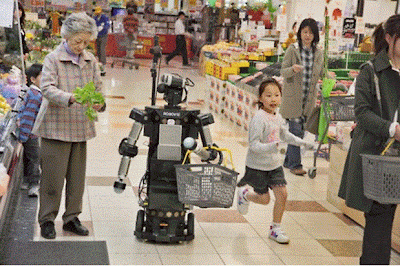This picture is from the National Geographic website as part of their feature ‘7 Billion Population’. As the title suggests the global population is soon to reach this figure with an ever increasing proportion of elderly people.
The image shows a 69year old Japanese lady being assisted by a robot to do her supermarket shopping and was part of a research study by the researchers from Keihanna Science City, Kyoto, Japan. In a country with a population of 128million, 29million are elderly and already outnumber the young. This has raised concerns about who will be able to care for their older generations in years to come and what are the possible alternatives to relying on humans for support.
The concepts of robots assisting or replacing humans in industry is nothing new, but incorporating them into our every day lives is perhaps considered, by most, as still being slightly unnerving. The films Terminator and iRobot spring to mind!
The design of substitute support humans would need to be robust and look at not only the user requirements but also how the two would interact: for example, would the user respond to voice, touch etc, could the robots perform multi-functions, would they be able to ‘talk’ to their owners and what happens in the event of a break down or malfunction, especially in the middle of a supermarket? Further consideration would need to be given to training the users how to interact with the robots and this could prove difficult with the population groups that would perhaps benefit the most, such as the elderly.
Nevertheless, in the future, the integration of robots into everyday civilization could be a feasible option to help solve some serious issues as a result of our ever demanding global population, but the success is likely to rely heavily upon the human being kept at the centre of the design.
Labels: aging, healthcare
